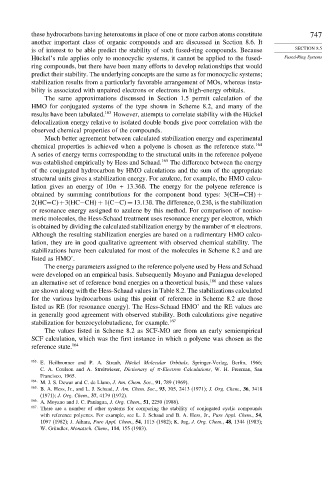Page 764 - Advanced Organic Chemistry Part A - Structure and Mechanisms, 5th ed (2007) - Carey _ Sundberg
P. 764
these hydrocarbons having heteroatoms in place of one or more carbon atoms constitute 747
another important class of organic compounds and are discussed in Section 8.6. It
is of interest to be able predict the stability of such fused-ring compounds. Because SECTION 8.5
Hückel’s rule applies only to monocyclic systems, it cannot be applied to the fused- Fused-Ring Systems
ring compounds, but there have been many efforts to develop relationships that would
predict their stability. The underlying concepts are the same as for monocyclic systems;
stabilization results from a particularly favorable arrangement of MOs, whereas insta-
bility is associated with unpaired electrons or electrons in high-energy orbitals.
The same approximations discussed in Section 1.5 permit calculation of the
HMO for conjugated systems of the type shown in Scheme 8.2, and many of the
results have been tabulated. 163 However, attempts to correlate stability with the Hückel
delocalization energy relative to isolated double bonds give poor correlation with the
observed chemical properties of the compounds.
Much better agreement between calculated stabilization energy and experimental
chemical properties is achieved when a polyene is chosen as the reference state. 164
A series of energy terms corresponding to the structural units in the reference polyene
was established empirically by Hess and Schaad. 165 The difference between the energy
of the conjugated hydrocarbon by HMO calculations and the sum of the appropriate
structural units gives a stabilization energy. For azulene, for example, the HMO calcu-
lation gives an energy of 10 + 13.36ß. The energy for the polyene reference is
obtained by summing contributions for the component bond types: 3 CH=CH +
2 HC=C +3(HC−CH) + 1(C−C) = 13 13ß. The difference, 0 23ß, is the stabilization
or resonance energy assigned to azulene by this method. For comparison of noniso-
meric molecules, the Hess-Schaad treatment uses resonance energy per electron, which
is obtained by dividing the calculated stabilization energy by the number of electrons.
Although the resulting stabilization energies are based on a rudimentary HMO calcu-
lation, they are in good qualitative agreement with observed chemical stability. The
stabilizations have been calculated for most of the molecules in Scheme 8.2 and are
listed as HMO’.
The energy parameters assigned to the reference polyene used by Hess and Schaad
were developed on an empirical basis. Subsequently Moyano and Paniagua developed
an alternative set of reference bond energies on a theoretical basis, 166 and these values
are shown along with the Hess-Schaad values in Table 8.2. The stabilizations calculated
for the various hydrocarbons using this point of reference in Scheme 8.2 are those
listed as RE (for resonance energy). The Hess-Schaad HMO’ and the RE values are
in generally good agreement with observed stability. Both calculations give negative
stabilization for benzocyclobutadiene, for example. 167
The values listed in Scheme 8.2 as SCF-MO are from an early semiempirical
SCF calculation, which was the first instance in which a polyene was chosen as the
reference state. 164
163 E. Heilbronner and P. A. Straub, Hückel Molecular Orbitals, Springer-Verlag, Berlin, 1966;
C. A. Coulson and A. Streitwieser, Dictionary of -Electron Calculations, W. H. Freeman, San
Francisco, 1965.
164
M. J. S. Dewar and C. de Llano, J. Am. Chem. Soc., 91, 789 (1969).
165 B. A. Hess, Jr., and L. J. Schaad, J. Am. Chem. Soc., 93, 305, 2413 (1971); J. Org. Chem., 36, 3418
(1971); J. Org. Chem., 37, 4179 (1972).
166 A. Moyano and J. C. Paniagua, J. Org. Chem., 51, 2250 (1986).
167
There are a number of other systems for comparing the stability of conjugated cyclic compounds
with reference polyenes. For example, see L. J. Schaad and B. A. Hess, Jr., Pure Appl. Chem., 54,
1097 (1982); J. Aihara, Pure Appl. Chem., 54, 1115 (1982); K. Jug, J. Org. Chem., 48, 1344 (1983);
W. Gründler, Monatsch. Chem., 114, 155 (1983).

